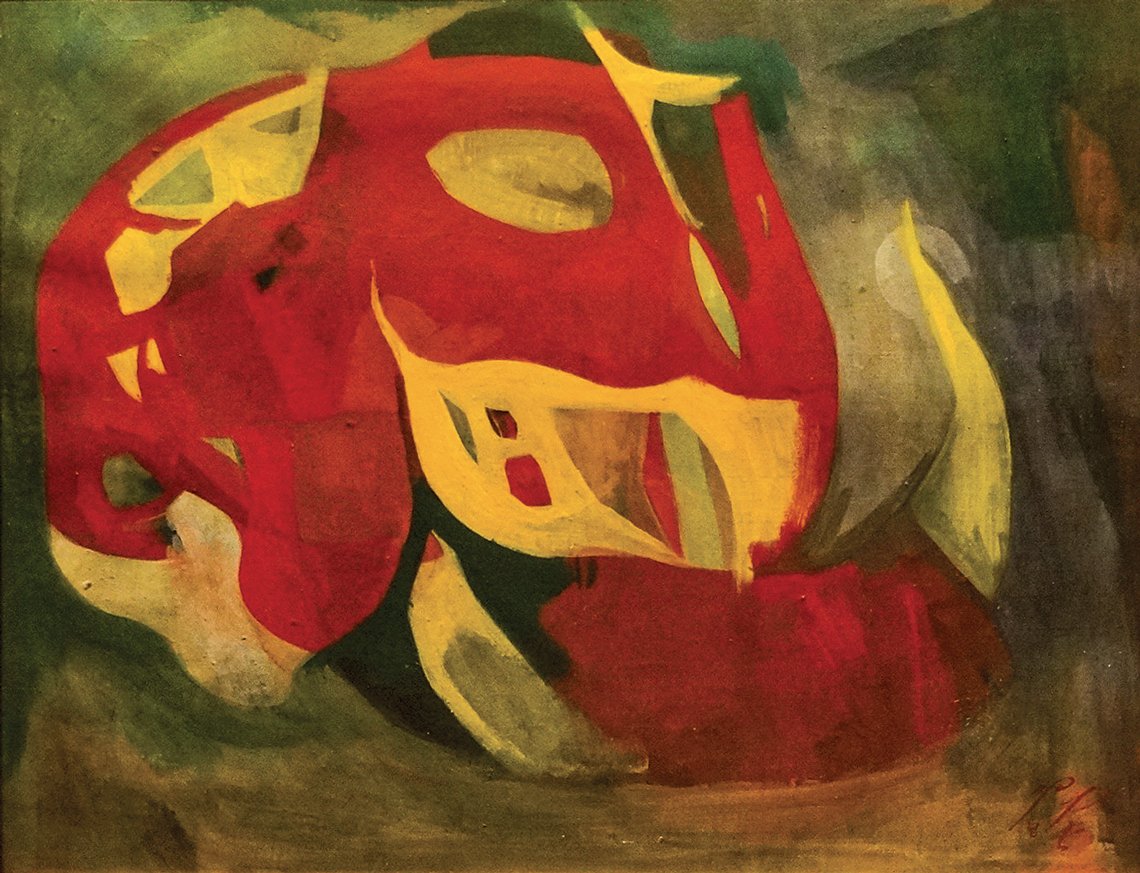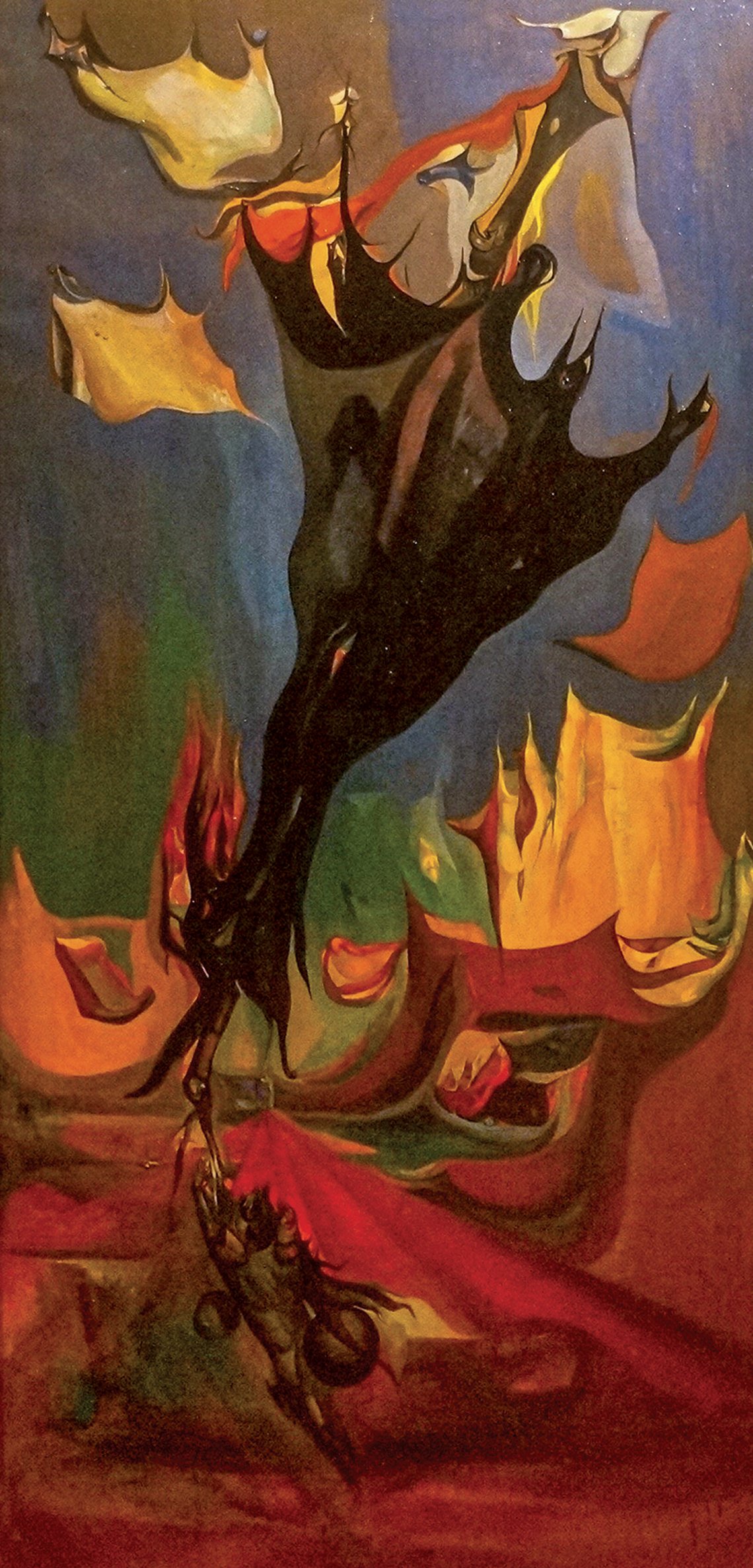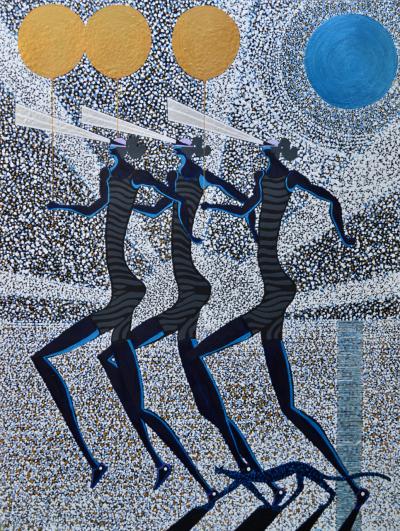Leon Kelly: American Surrealist
 |
Leon Kelly (1901–1982), El Capitan, 1936. Oil on canvas, 12 x 15¼ inches. |
 | |
Leon Kelly (1901–1982), Gigantic Umbrella, 1940. Oil on canvas, 51 x 24 inches. |
Leon Kelly (1901–1982) was the only child of Elizabeth and Pantaleon L. Kelly. When in his twenties, his parents’ unhappy marriage ended, and his father’s business as a tailor dissolved. Kelly worked to support his mother and grandmother while also pursuing his dream as an artist.
A gifted draftsman, Kelly earned a scholarship to the Pennsylvania Academy of Fine Art in Philadelphia, the premier art school in the country. His artwork from the PAFA years had a distinct academic flavor. After graduating from PAFA in 1924, Kelly was granted a fellowship that allowed him to travel to Paris, where he studied the Old Masters, Titian, Rubens, Tintoretto, and Velasquez, among others. During this early period, Kelly’s style became less rigid, transmuting to Impressionism and then subsequently to a Post-Impressionist mode. His works show evidence of his influence from the French artists he admired, and he portrayed villages and landscapes with a visible European sensibility; the broken brush strokes, the melding of colors, and even the perspective reflected the French masters, yet there was a discernible individuality solely that of Leon Kelly’s.
While Kelly would utilize the Old-World methodologies throughout his career to suit his own vision, from the middle to late 1920s, Kelly’s work explored the dissolution of form and color while remaining faithful to the overall concept of his subject. Whether landscape, interior with figure, still life or group, his works were a master of perspective, juxtaposition and balance.
In the 1930s, he exhibited in Philadelphia and was connected with the avant-garde group aligned to the colorist Arthur Beecher Carles. Albert Barnes, the collector and patron of the arts, admired Kelly’s work and helped finance him through some difficult times. Julian Levy, a prominent art dealer in New York also took note of Kelly and showed his work in his gallery during the 1940s and 1950s. Through his presence at Levy’s gallery, Kelly became acquainted with such established artists as Max Ernst, Salvador Dali, Yves Tanguy, Pavel Tchelitchew, Eugene Berman, and other artists who would become well known, such as Joseph Cornell and Arshile Gorky. All of these artists in various ways influenced Kelly’s output in the coming years. His work was also shown in group and solo shows at the Pennsylvania Academy of Fine Arts, the Whitney Museum, the Museum of Modern Art, the Corcoran Gallery, The Newark Museum, and the St. Louis Museum.
 |  | |
left: Leon Kelly (1901–1982), Man with Kites (The Messenger), 1943. Oil on canvas, 40 x 30 inches. right: Leon Kelly (1901–1982), Bather Emerging from the Sea, 1952. Oil on canvas, Size 36 x 26¼ inches. | ||
 |  | |
left: Leon Kelly (1901–1982), The Cascade of Souls, 1958. Oil on canvas, 50 x 40 inches. right: Leon Kelly (1901–1982), Paysage En Pollensa, 1960. Oil on canvas, 30 x 36 inches. | ||
Kelly demonstrated his enormous talent for executing stunning works in Cubism, Social Realism, and Abstraction through the 1940s into the 1970s. It was in the 1940s, however, where he was recognized for a style of painting that defined Surrealism. Indeed, he was indebted to the liberating influence of Surrealism, a vehicle by which to express his unique style.
A reclusive, he would not be defined or restricted by the prescribed dictum of the society and critics around him. Kelly experimented with imagery that seemed exaggerated in both scale and shape. The visual illusions the artist created presented an alternate reality. His depiction of large, anthropomorphic insect-like creatures and unearthly figures seemed illogical but were rendered in such detail and clarity that they seemed to really exist.
 |
Leon Kelly (1901–1982), Maya with Mallorcan Fan, 1962. Oil on canvas, 36 x 49 inches. |
Kelly had the ability to bring into being a pure symphony of shapes and colors. In his works of the 1950s, 1960s and 1970s, he excelled with relentless passion the architectural execution of his journey into Surrealism. The compositions of his late Surrealist works were the culmination of a life-long quest to share his vision with the world. He is known today as the American Surrealist.
Kelly died in 1982, in Loveladies, New Jersey, at the age of 81. His works are in the permanent collections of the Philadelphia Museum of Art, The Metropolitan Museum of Art, the Whitney Museum of Art, and MoMA, among others, and in many major private collections.
Carl David is director of the David David Gallery, Philadelphia, and author of Collecting and Care of Fine Art (2016).
This article was originally published in the 2019 Anniversary/Spring issue of Antiques & Fine Art magazine, a fully digitized version of which is available at www.afamag.com.































